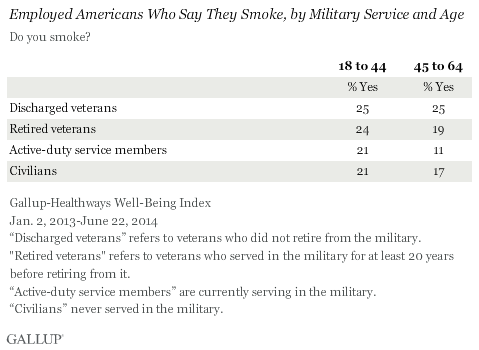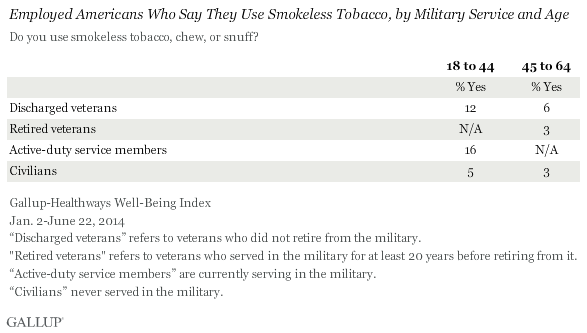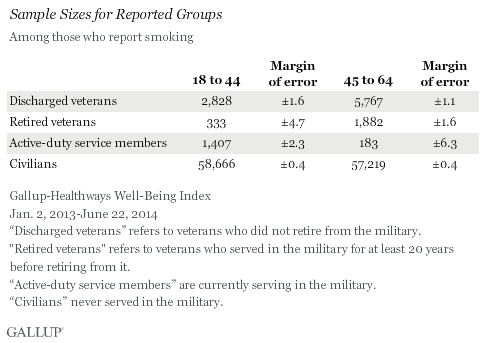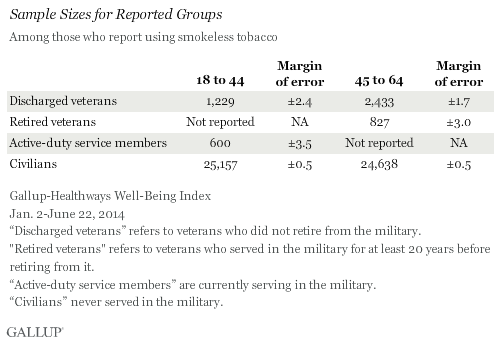This article is part of a weeklong series analyzing the veteran experience in the United States, especially how returning veterans transition from the military to civilian life.
WASHINGTON, D.C. -- Employed veterans are slightly more likely to say they smoke than active-duty service members or civilian workers.

Among those both age groups, discharged veterans are more likely to smoke than any other group. A quarter of discharged veterans aged 45 to 64 report smoking, compared with 19% of older retired veterans, and even lower percentages among active-duty service members and employed civilians. Across both age groups, active-duty service members are tied with or the least likely to smoke.
These findings are based on 128,285 interviews with employed Americans, aged 18 to 64, from Jan. 2, 2013 through June 22, 2014, for the smoking metric, and 40,175 interviews Jan. 2, 2014 through June 22, 2014, for the smokeless tobacco metric, conducted as part of the Gallup-Healthways Well-Being Index.
"Discharged veterans" refers to veterans who did not retire from the military. "Retired veterans" refers to veterans who served in the military for at least 20 years before retiring from it. "Active-duty service members" are currently serving in the military. "Civilians" never served in the military. Of these completed surveys, 1,590 were with active-duty service members residing in the U.S. at the time they were interviewed, 8,595 were with discharged veterans, and 2,215 were with retired veterans. The numbers for these same groups are 508, 2,631, and 702, respectively, for smokeless tobacco.
For smokeless tobacco, there are insufficient data to report for active-duty service members aged 45 to 64 and retired veterans aged 18 to 44.
Active-Duty Service Members' Smokeless Tobacco Use Doubles Civilian Population's
In contrast to smoking, smokeless tobacco use is highest among active-duty service members, with 16% among those aged 18 to 44 reporting using it. While discharged veterans aged 18 to 44 are less likely to use smokeless tobacco than those who remain active in the military, the 12% of those who do far outweigh their civilian counterparts, 5% of whom are users. Use of smokeless tobacco is lower among all groups in the 45-to-64 age range, but discharged veterans in this age group use smokeless tobacco at twice the rate of what is found among civilians and retired veterans.

Bottom Line
These results support ideas that tobacco use in its two primary forms is a serious issue for veterans, but not uniformly. Tobacco use, including smokeless tobacco, is heavier among veterans than their civilian counterparts, particularly among discharged veterans. Regarding smokeless tobacco, the data show that although its use is not that common for any group, but it is relatively high among 18- to 44-year-olds active in the military and discharged veterans. It is unclear whether the use of smokeless tobacco is something younger adults pick up in the military, or if those who show higher rates of usage are more likely to enlist in the military. Additionally, various restrictions on smoking in the military -- mirroring smoking bans in the civilian workforce -- could be responsible for a shift in smokeless tobacco usage.
Regardless, the results illustrate a behavioral divide between those who are active duty and their veteran counterparts and underscore what appears to be a transformation in tobacco use in the military today. While cigarette smoking may have been the norm in the old military -- in a time when cigarettes were included in soldiers' C-ration boxes -- today's active-duty service members seem to have shifted to using smokeless tobacco. This shift could reflect a reaction to the military services' crackdown on smoking in many military workspaces and in combat situations in which it could be tactically dangerous.
Survey Methods
These findings are based on 128,285 interviews with employed Americans, aged 18 to 64, from Jan. 2, 2013-June 22, 2014, for the smoking metric and 40,175 interviews Jan. 2, 2014-June 22, 2014, for smokeless tobacco, conducted as part of the Gallup-Healthways Well-Being Index. Of these completed surveys, 1,590 were with active-duty service members residing in the United States at the time they were interviewed, 8,595 were with non-career discharged veterans, and 2,215 were with career retired veterans. The numbers for these same groups are 508, 2,631, and 702, respectively, for smokeless tobacco.
Margin of error ranges increase for individual age groups within each category. Page 2 provides a summary of these margin of error ranges.
Interviews are conducted with respondents on landline telephones and cellular phones, with interviews conducted in Spanish for respondents who are primarily Spanish-speaking. Each sample of national adults includes a minimum quota of 50% cellphone respondents and 50% landline respondents, with additional minimum quotas by time zone within region. Landline and cellular telephone numbers are selected using random-digit-dial methods. Landline respondents are chosen at random within each household on the basis of which member had the most recent birthday.
Samples are weighted to correct for unequal selection probability, nonresponse, and double coverage of landline and cell users in the two sampling frames. They are also weighted to match the national demographics of gender, age, race, Hispanic ethnicity, education, region, population density, and phone status (cellphone only/landline only/both, and cellphone mostly). Demographic weighting targets are based on the most recent Current Population Survey figures for the aged 18 and older U.S. population. Phone status targets are based on the most recent National Health Interview Survey. Population density targets are based on the most recent U.S. census. All reported margins of sampling error include the computed design effects for weighting.
In addition to sampling error, question wording and practical difficulties in conducting surveys can introduce error or bias into the findings of public opinion polls.
For more details on Gallup's polling methodology, visit www.gallup.com.


Questions used to discern military or veteran status include:
- Have you, or has any member of your household, ever served in the U.S. military?
- Are you currently on active duty, or not?
- Which of the following describes your current status: retired from active duty, discharged from active duty, National Guard, Reserve, Individual Ready Reserve, or something else?
